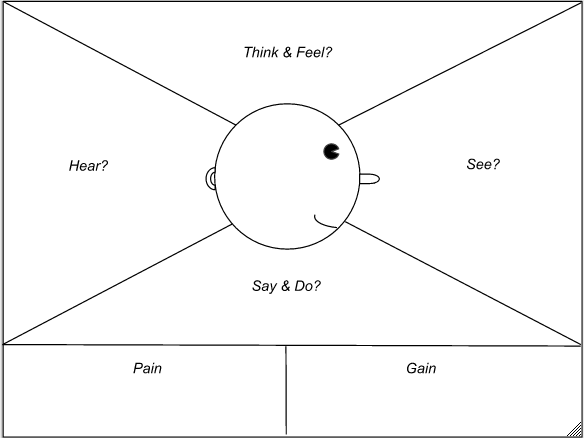In a recent blog post, I talked about the initial steps in the process of creating your customer avatar. Today, I’d like to take you deeper into the process so you can really flesh out your avatar and give yourself perfect clarity about who you’re trying to reach and serve in your consulting business.
But first, a little backtracking: If you didn’t read the previous post and do the two exercises, please go there now, give it a quick read, and do the two exercises you find there. It will only take you about five to ten minutes. If you did the exercises and hung onto them as I instructed you to, pull them out now. You’re good to go on to the next step.
Once you have those two exercises from the previous post completed, here’s what you should have:
- A list of your core values and beliefs that reflect what you want your business to be known for.
- A short paragraph describing, in general, the kind of people you’d like to work with in your business (those in your target market who resonate with your values and beliefs).
- A short paragraph describing, in general, the kind of people you don’t want to work with in your business (those who don’t resonate with your values and beliefs).
- A list of descriptive words and phrases that describe the people who are in a position to hire you to do the kind of work you’d like to do as a consultant.
- A list of descriptive words and phrases that describe the people who will be the end-users of your materials—attendees at your workshops, buyers of your books and other materials, students in your online courses, etc.
- A descriptive paragraph describing one single person who embodies those characteristics that are found on both of the previous two lists (what those two groups of people have in common) and who matches well with your values and beliefs.
Once you have created the materials above, you have a decent foundation upon which to build out your customer avatar.
Now, let’s take it to the next level.
Adding Detail through Demographics
The next step in the process requires some research. Depending on your personality, you may enjoy this process, or it may be a bit of a slog. Either way, it’s crucial, and it can’t be skipped. So here goes.
First, you need to gather some demographic data. Pull out the descriptive paragraph you wrote earlier, the one that combined the common characteristics of the people in a position to hire you and the people who are likely to be the end-users of your material. This is your “starter avatar” that we will be fleshing out.
Now, reread your paragraph and start trying to nail down some details.
To demonstrate, let’s take a look at the “starter avatar” paragraph I included in the previous blog post. You may recall that the fictional consultant in our example was a language arts consultant who specializes in reading and writing workshop methodology for elementary school students.
Here’s the paragraph I wrote for the exercise:
“Ellie Educator loves kids and believes that they can think at a high level and produce amazing work when given the freedom to follow their interests and express their ideas. She believes that great teaching involves as much personalization as possible within a framework that allows all kids to learn needed skills and content knowledge. She also believes that standardized tests and benchmark tests are important (even though she isn’t a real fan of them) because they give parents and district planners useful data. Toward this end, she believes that a reading/writing workshop model is the best approach for her language arts instruction, as it allows freedom of choice (what books to read, what topics to write about), which is motivational for her students, within an instructional framework that allows her to teach needed skills.”
Now, there’s an obvious demographic assumption right at the beginning. I’ve made this example avatar female. Why? In my experience, there are more female primary grades teachers than male primary grades teachers. But is that true? Let me check it out.
OK, I just Googled “Demographic data on American teachers.” One article, “The Nation’s Teaching Force is Still Mostly White and Female” from Education Week, answers a couple of questions right in the title.
But to give you a few stats from the article itself, it says, “About 77 percent of teachers are women—up slightly from 76 percent in 2012. In primary schools, nearly 9 in 10 teachers are women. In high schools, less than two-thirds are” (Loewus, 2017). So, my assumption that most of the teachers this fictional consultant would be working with would be women is on target.
In my paragraph, I didn’t nail down a race for the avatar. If I wanted to continue down this path of creating an avatar that looks like the majority of people our fictional consultant would probably work with, then the demographic data says that Ellie is white.
How about age? According to the article, “The average age of teachers is 42, down slightly from 43 in 2012” (Loewus, 2017). So, if we want Ellie to represent the average primary grades teacher, that’s the age we’ll go with.
Can you see already how our conception of this fictional avatar, Ellie Educator, is sharpening? She is female, white, and 42 years old.
Now, some of you are probably thinking, “Wait a minute. Maybe I don’t want to create an avatar that is the average of my target audience group. Maybe I want to serve a sub-group that doesn’t look like that average at all.”
No worries. That point is perfectly legitimate.
But once again, you still want to use what demographic data you can to start to flesh out your avatar.
Say, for example, that you write and speak about social justice, implicit bias, and racial inequity in education as your primary focus and that you want to work in urban secondary schools where the teacher population looks very different than the national averages.
Great. But you still want to find some data. According to one article I read, America’s teacher population is much less diverse than the student population. While 51% of American students are non-white, even in urban schools only 31% of teachers are non-white (though that is much higher than the percentage in suburban and rural schools) (Geiger, 2018).
So, do you still make your customer avatar white in this situation? It depends. Who do you feel you’re primarily speaking to? The non-white teachers in the group who you want to turn into evangelists for the cause? Or perhaps the white teachers in the group who may need the information more? It’s totally your call.
The point I’m making is simply that you want to look at actual data as you try to create your customer avatar because you want your avatar grounded in reality.
Empathy Mapping to “Get Inside Your Avatar’s Head”
Alright, so now you’ve used some demographic data to flesh out your avatar a bit. You should probably have nailed down your avatar’s gender, race, age, and yearly income at the very least.
Now it’s time to dig deeper. And to do so, I want to introduce you to empathy mapping. If you Google “empathy map,” you’ll find lots of versions. Here’s one basic example:

The goal of using an empathy map is to really figure out what makes your customer avatar “tick.” To do so (at least using the version above), you are going to fill in as much detail as you can in each section of the graphic organizer.
Here are short descriptions of what needs to go in each section (alternatively, you can simply create a Word document with a different page for each category):
- Think and Feel: What does you customer avatar think about as he goes through the typical day? What does he feel, as far as emotions, in certain situations?
- Hear: What are the kinds of things your customer avatar is likely to hear in the different places she visits throughout the day?
- See: What sights does your customer avatar see throughout his typical day?
- Say and Do: What does your customer avatar say to different groups of people during the typical day? What actions does she take?
- Pain: What situations, events, and topics cause your customer avatar problems or pain in his life (work and personal)? What keeps him up at night?
- Gain: What does your customer avatar wish to achieve in her career and life? What is she striving for?
Now, go ahead and take a crack at filling out as much of the empathy map as you can from your own experience. You already know a lot about the kind of people you want to work with and serve, so put that knowledge to use.
Once you’ve done that, there are a number of tools and tactics you can use to dig up more information, and if I get into too detailed a description at this point, I fear that we’ll get bogged down and lose the thread of this post, so I’m going to just give you some general to-do steps here and then I’ll come back in a future post and go deeper.
There are two main approaches that I would suggest you do to find the information for your empathy map: keyword research and social media lurking.
First, keyword research. If you’re not familiar with keyword research at all, it’s simply the process of using some technical tool or tools to identify what words and/or phrases (called “keywords” and “keyword phrases” in SEO parlance) people are using to try to find information in a search engine such as Google.
There are a number of such tools out there. Three that I’ve used are Wordtracker (wordtracker.com), Answer the Public (answerthepublic.com), and Neil Patel’s UberSuggest (neilpatel.com/ubersuggest/). All of these have free versions that are fairly limited in what results they will give you and paid versions that are much more robust.
You might be able to get enough data for your customer avatar development with the free versions, but only you can make that call. My current favorite is UberSuggest, and I use the paid version, which allows me to do some amazing research, but that may be overkill for your purposes unless you really want to learn a lot about SEO.
Anyway, take a look at these tools, choose one to work with, and then start entering some of the main keyword phrases you think your ideal customer would be looking up in a search engine. For example, Ellie Educator, being a primary grades language arts teacher who uses reading and writing workshop methodology, might type “reading workshop” or “writing workshop” into a search engine when looking for more information. So, YOU (if you were the language arts consultant trying to figure out what makes Ellie tick) would want to put those phrases into your chosen keyword research tool.
When you do, you’ll see a long list of results that will tell you, not only how many people worldwide have searched for those terms in the past month, but you’ll also find out other information such as how much competition there is for each term (how many other web pages use it).
As you browse the results, you will start to see the kind of language people are using when they search for the term(s) you entered into the tool. Some of the results might surprise you. You may learn, for example, that a term you thought would be heavily searched is not searched for that often after all. Conversely, you may find that some terms you would never have thought would be popular search terms are actually searched more often than the one you entered into the tool.
What you’re after here is to see what kinds of search terms and language are popular and find a way to add that information into your empathy map. For example, if “how to train kids to write independently” shows up as a popular search term, you might want to enter that into your “Pain” section (the people searching for that phrase are clearly looking for the solution to a problem). If you see “best arrangement for a workshop classroom” as a popular search, you might enter it into the “See” section, as people searching for this phrase are looking for information about how a workshop classroom should look. Get the idea?
If you want to hang onto the actual data (number of searches, for example), you might also enter it into a spreadsheet in addition to adding it to your empathy map. This information will come in very handy later if you decide that you do want to learn more about how to use SEO to get your site to rank higher in search.
OK, now how about social media lurking? Sounds a little nefarious, doesn’t it? But it’s all on the up-and-up. Here’s what I mean by social media lurking.
Imagine what social media platforms your ideal client/customer would spend time on. Facebook? Twitter? LinkedIn? Instagram? Use your knowledge of your audience to guide you to the correct platforms.
Once there, visit groups where your audience would likely hang out. Check out hashtags that would resonate with your audience members. Go into these groups and discussion threads and lurk—and by lurk, I mean simply see what people are talking about. What problems do they talk about? What goals do they share? What kind of language do they use? All of this is great information for your empathy map. You don’t actually have to participate in the discussions (unless you want to). Just capture anything that you see showing up multiple times and put it in the appropriate sections of the map.
When you’ve (1) used your own experience, (2) done some keyword research, and (3) some social media lurking, you should have gathered a decent amount of raw material into your empathy map. Now it’s time to take this raw material and add it into your customer avatar description.
A Fictional Character Based on Facts
The next step of the process is to take your “starter avatar” paragraph (that you enhanced with as many facts as possible in the previous step) and write as complete a description of your ideal customer as you possibly can, adding in details from your empathy map as you go.
The goal here is to write your customer avatar up as if he or she was a fictional character. You know how, early in a good novel, the author will spend some time fleshing out the main characters of the book with lots of detail? That’s what you’re after.
And, of course, to some extent, your customer avatar IS a fictional character—no one person on Earth will exactly match the description you write up.
But in another way, your customer avatar is very real. This is because you have built up this fictional character based on a lot of real-world data. You started by generalizing what you already know about the group of people your customer avatar represents. You used all of your experience with this group of people as you did this.
You then went on to look up some demographic data about this group and you added this data into your description. You then did some keyword research and discovered the kinds of topics your ideal customers were looking for in search, including the exact wording they use. Finally, you spent a little time lurking around social media and gained even more insight into this group.
So yes, your avatar is a fictional character, but he or she is also based on a whole lot of facts. This is why you can feel comfortable building your business to serve the needs of your ideal customers—because you know them so well!
Write It as a Narrative
Finally, as you write you expanded customer avatar to include the information from your empathy map, be sure to write it up in a narrative form. In other words, don’t just describe your customer avatar, tell his or her story.
Why is this so important? Because human beings tend to think in terms of stories. In fact, we all walk around the world every day telling ourselves our own story inside our heads (we are all the heroes of our own stories).
So, if you’re going to really get to know your ideal customers, you want to start imagining your customer avatar’s life. How does he go through his day? What challenges does she face? How does he deal with adversity? What does she dream of achieving?
The more you can flesh out your customer avatar and make him or her come to life, the better you will be able to make decisions in your business because everything will be geared toward solving this person’s problems and helping him or her achieve their goals.
How long should your customer avatar description be? There’s no set rule. But I will tell you that my customer avatar for my business is over five pages long, single-spaced. In fact, I feel like I know my customer avatar better than I know some of my close friends and family members. That’s what you’re striving for.
So take your time with this. Work on it some, put it aside, pull it back out and add more detail. Imagine this person as intensely as you can. This is one of the most valuable processes you can ever go through for your business success, and you’ll never be completely done.
I’ll circle back around to this topic and take you even deeper into it in future blog posts, but I think I’ve given you a big enough assignment for now.
And if you have questions or comments, please feel free to comment on this blog post or send me an e-mail. I’d love to hear from you.
Sources
Geiger, A. W. (2018, August 27). America’s public school teachers are far less racially and ethnically diverse than their students. FacTank: News in the Numbers: Pew Research Center. Retrieved from: https://www.pewresearch.org/fact-tank/2018/08/27/americas-public-school-teachers-are-far-less-racially-and-ethnically-diverse-than-their-students/
Loewus, Liana. (2017, August 15). The nation’s teaching force is still mostly white and female. Education Week. Retrieved from: https://www.edweek.org/ew/articles/2017/08/15/the-nations-teaching-force-is-still-mostly.html





